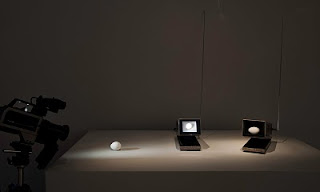Museum, Washington. This 49-channel installation is neon, steel and other electrical parts.
His last video sculpture made in 2005, Ommah (mother in Korean) uses a 100-year-old boy's robe, hanging like a cross, with a projection of Korean-American girls at play, linking past and present. It is in the National Gallery's permanent collection
To fully appreciate his work one must see the exhibition in the museum's East Wing. His art is about tv/video, a relatively new medium in visual art. A room of Paik's drawings accompany the exhibition and help the viewer understand his thought process. One of the most interesting takes us back to the 60s culture; it's a drawing of the Pan Am domestic routes represented by bunny-eared TV icons connected by red lines. He seems to have projected that many networks of our lives have been influenced by TV, and perhaps have changed us.
Paik, who died in 2006, is credited with bringing this medium into the realm of contemporary art. Compared to other video artists (there are many today!), Paik is certainly a multimedia artist who thought more in terms of how television and its relatives can be incorporated into art, rather than end and aim of the art itself.
 One Candle, Candle Projection, 1988-2000 candle, candle monitoring device, closed circuit camera, projectors, distribution amplifier, and 5" color monitor, dimensions variable Nam June Paik Estate
One Candle, Candle Projection, 1988-2000 candle, candle monitoring device, closed circuit camera, projectors, distribution amplifier, and 5" color monitor, dimensions variable Nam June Paik Estate
© Nam June Paik Studios, Inc. 2010
He used knowledge of technology and contemporary art to reflect on traditional cultural identities. He was vastly concerned with bringing together aspects of the past with the present. One Candle, One Projection, 1988-2000, is the centerpiece of the exhibition, and one can only grasp its power by experiencing it in the large, dark exhibition room. The dim lighting of the viewing space is ideal for the meditative concepts here. A single candle is lit everyday and a multiplicity of projections move, flicker and interact as the viewer is invited to watch. Time, or the passage of time, is of the essence.
In seeing the Paik exhibition, I appreciated this modern artist's ability to think about the contemporary aims of the society within which he was working and then make a statement. Personally, he disliked the passivity of television but could not ignore its influence on culture. In an ironic play on this notion, his Standing Buddha with an Outstretched hand is a meditation on the act of watching, using a traditional bronze sculpture as a backdrop to the modern technology. Time passes, but the statue stays the same, and Paik effectively made a statement on the meaning of television in life while connecting it to traditional meditation. Paik was trained a a classical musician and was friends with John Cage.
Three Eggs, 1975-1982
video installation with closed circuit camera, Sony KV-4000 Color Television Receiver, emptied Sony KV-4000 Color Television Receiver, and 2 hen eggs
Nam June Paik Estate © Nam June Paik Studios, Inc. 2010
Like 20th century artists of the Dada, Surrealist and Conceptual movements, his Three Eggs reflects on the question of what is real and what is image. Three Eggs is 1) a video camera projecting on an egg; 2) a tv screen showing the projected image of this egg, and 3) a tv monitor with the screen removed-- replaced by an egg. There is irony and humor, but the passage of time is important to these 3 images, as well, having been made over 7 years. It reminds the student of Joseph Kosuth's One and Three Chairs or Rene Magritte's Treason of Images, 1929, works found in most art history textbooks.video installation with closed circuit camera, Sony KV-4000 Color Television Receiver, emptied Sony KV-4000 Color Television Receiver, and 2 hen eggs
Nam June Paik Estate © Nam June Paik Studios, Inc. 2010
